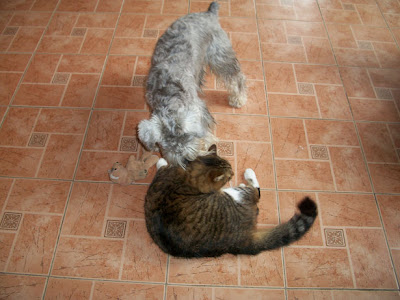It was November and I had spent 3 months searching for just the
right puppy.
 |
| MAX |
Finally we had found what we considered to be the
perfect one. Luckily she was already 7 weeks old so she could
already be separated from her mother.
I was so excited when we brought her home, our new addition to the family. I made
sure I had all the required supplies; food and water dishes, food, a bed and a
crate. We were ready. The fact that we already had a cat never
really caused me much concern. I figured they would give each other
a good sniff and surely it would not take long for them to become the
best of friends and live happily ever after.
 |
| A friendly Cat 'n' Dog |
I had visions of our little puppy all curled up with our cat in front of the fireplace.
Reality hit when I walked into our house carrying a crate with our
newest family member inside. Our dog is a female so I will use she
when referring to a dog. The cat seemed a little curious so in a
moment of obvious brain freeze I took the puppy out of the crate to
introduce the two.
Our cat in a split second armed herself for
battle. The hair was straight up making her look like I had just
taken her out of the dryer and she started hissing and growling as if
her opponent was a rottweiler rather than a puppy that could fit in
my hand. The poor puppy could barely walk so she just fell into a
ball and shivered and whimpered. I'm sure that as soon as we removed
the dog and put her back in her crate, the cat went to her bed and
started plotting a way to have the new puppy just suddenly "disappear"
like getting flushed down the toilet.
 |
| Cat 'n' Dog |
She considered herself to be
the queen of the household and it was obvious that there was going to
be a battle for the crown. Boy had I called this meeting wrong!
In an attempt to help you avoid a similar situation I'm going to outline
a few pointers as to what you SHOULD do when you introduce your new
puppy to your resident pet. This information comes from research
done concerning raising a puppy, unfortunately the how to introduce
guidelines would have been much more beneficial if found BEFORE the
actual deed was done.
Firstly the introduction must be done slowly. If possible take a
towel and rub the new puppy with it then bring it home and put it
somewhere that your resident pet will frequent and be able to smell.
This will also work if you take something that has the scent of your
existing pet on it and put it in the carrier you bring your new puppy
home in.
When you first bring a new animal into your home she should
stay quarantined from the other animals until it has seen the vet.
Once she has seen the vet you will still need to keep her separate
from the other animals.
Allow the animals to smell the new puppy
from under the door so they may become to each other. After a few
days to a week you can try the introduction but make sure you are
close in case you have to take on the roll of referee. If there is
some growling or paw raising don't interfere unless of course you
feel your puppy is in danger.
If your puppy is being crate trained
you can put her back in the crate and continue to take her out for
short intervals to spend time with the other animal. Make sure the
amount of time you let them spend together is increased gradually.
 |
| Doberman puppy with a German Shepherd |
Most importantly never leave the two animals alone and be sure to
flood the resident animal with love and attention so they feel secure
in their place in the family. This will greatly reduce the risk of
having the new puppy take a whirl in the toilet. If you want all
animals to live in harmony you have to be patient and let the animals
deal with each other in their own way and in their own time.
 |
| Comfy Cat |
Author: Cass Hope
Cass Hope has been a writer for over 5years. Cass regularly
contributes to online and offline publications in a variety of
areas. She also teaches classes in basic obedience for puppies.
She is currently sponsoring this site: http://www.1st4dog-
training.info
Article Source: http://www.articlealley.com/article_5461_54.html
Contact him at http://www.1st4dog-













.jpg)

